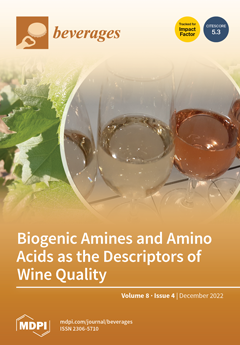Pulsed electric field (PEF) treatment of red wine samples with energies changing from 2.4 to 13.2 kJ to inactivate
Saccharomyces cerevisiae,
Hansenula anomala,
Candida lipolytica,
Lactobacillus delbrueckii ssp.
bulgaricus, and
Escherichia coli O157:H7 with the determination of the changes
[...] Read more.
Pulsed electric field (PEF) treatment of red wine samples with energies changing from 2.4 to 13.2 kJ to inactivate
Saccharomyces cerevisiae,
Hansenula anomala,
Candida lipolytica,
Lactobacillus delbrueckii ssp.
bulgaricus, and
Escherichia coli O157:H7 with the determination of the changes in the quality and sensory properties in addition to metal ion concentration (Na, Mg, K, and Mn) were explored. Increased applied energy resulted in a significant increase in pH, conductivity, lightness (
L*), yellowness (
b*), and total phenolic substance content with significant inactivation of all microorganisms with no significant change in metal ion concentration. Sensory properties of particle status, sour taste, and aftertaste were significantly decreased, whereas the other measured properties were significantly increased by 13.2 kJ PEF treatment (
p < 0.05). Joint optimization studies for the most optimal processing parameters for the measured properties were 488 s, 0.13 kJ, and 0.22 kV; 488 s, 13.2 kJ, and 31 kV; 348 s, 9.39 kJ, and 31 kV/cm; and 488 s, 13.2 kJ, and 0 kV EFS, with 0.79, 0.69, 1.00, and 0.72 composite desirability, respectively.
Full article





